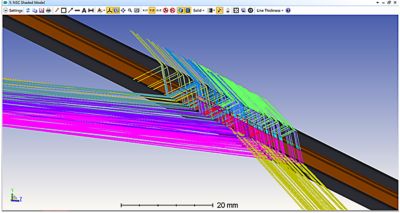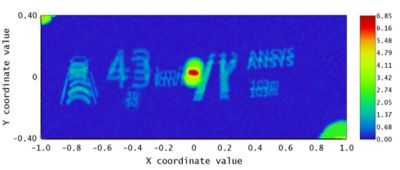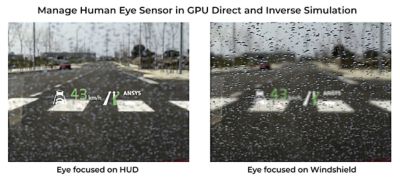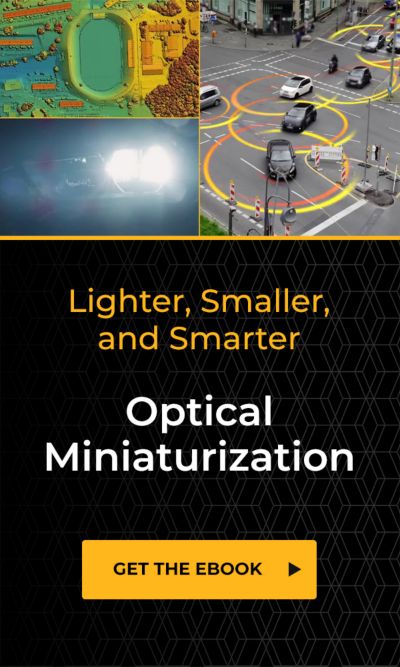-
United States -
United Kingdom -
India -
France -
Deutschland -
Italia -
日本 -
대한민국 -
中国 -
台灣
-
Ansys stellt Studierenden auf dem Weg zum Erfolg die Simulationssoftware kostenlos zur Verfügung.
-
Ansys stellt Studierenden auf dem Weg zum Erfolg die Simulationssoftware kostenlos zur Verfügung.
-
Ansys stellt Studierenden auf dem Weg zum Erfolg die Simulationssoftware kostenlos zur Verfügung.
-
Kontakt -
Karriere -
Studierende und Akademiker*innen -
Für die Vereinigten Staaten und Kanada
+1 844,462 6797

As major automakers invest in next-generation head-up displays, simulation can help address safety challenges.
To win in an increasingly crowded global market, automotive manufacturers need to differentiate themselves by offering innovative, next-generation technologies that help deliver a safe, comfortable driving experience. Head-up displays (HUDs) are emerging as a key area of innovation and competitive differentiation.
To help drivers keep their eyes on the road and minimize distraction, HUDs project critical information like speedometer readings, fuel levels, navigation guidance, and traffic warnings on the windshield or specialized mirrors in the driver’s line of sight. A form of augmented reality, HUDs have been adapted from the aviation industry for commercial automobiles as an important component of today’s advanced driver-assistance system (ADAS) platforms.
As drivers embrace this leading-edge technology, the market for HUDs is exploding. In fact, it’s projected to nearly quadruple in size over the next eight years, growing from $1.6 billion in 2023 to $7 billion in 2032.
The world’s biggest automakers are paying attention — and investing accordingly. Their focus is on expanding the currently relatively small area of HUDs to span the entire windshield, minimizing the need for drivers to ever look away from the road. Ford, BMW, and General Motors are all investing in patents and prototypes for full-windshield displays.
Perhaps the most ambitious development effort is being led by Hyundai, which plans to introduce windshield-spanning HUDs as early as the 2027 model year. Hyundai is also introducing a redesigned cabin that eliminates the dashboard, making the HUD’s glass area even bigger.

These images illustrate how, through refining the optimizer’s functions of merit, image quality can be improved. The ghosting effect can be corrected or mitigated using Ansys Zemax OpticStudio optical system design and analysis software. From left to right, the images show the original system, an intermediate improvement, and an optimized system.
Bringing Design Optimization to Light via Ansys
The development of HUDs has always been characterized by complex design challenges, principally because human perception is involved. Cross-functional design teams must not only address practical concerns like glass strength and projection system costs but differences in human behavior and visual ability. Designers must consider a wide range of legibility and lighting concerns, such as ghosting, distortion, warping, and chromatic aberration.
One of the greatest sources of uncertainty is stray light, which is defined as any unintended light that’s sensed by a detector or perceived by a human. If stray light comes from the HUD’s own optical components — for example, if light bounces off the windshield coating in an unexpected way — it can cause ghost reflections that confuse drivers or block their vision through the glass. Stray light can also originate from nonoptical components, such as the sun or oncoming headlights, causing unintended glare.
Obviously, as the surface area of a HUD increases, so does the risk of stray light interfering with the visibility of both display data and the road ahead. As HUD design has matured as a science, automotive engineering teams now have a range of tools and best practices at their disposal to mitigate stray light and its effects. They can change the angles, materials, substrates, coatings, and position of the HUD’s optical components. Engineers can also incorporate light traps — mechanical catches for undesired light paths — into their HUD designs.

Stray light can originate from within the head-up display (HUD) itself. Here, a substrate in the layered glass assembly creates an unwanted reflection, or glare, for the car’s driver.
But a tough question remains: How can HUD development teams accurately replicate the full range of human perception, identify every possible source of stray light, and eliminate unwanted optical phenomena before the costly prototyping and physical testing stages? The answer is engineering simulation.
Simulation is the only fast, feasible, and cost-effective way to model the HUD’s many components, replicate their performance under thousands of potential operating parameters, and make design adjustments in a low-risk virtual environment to minimize stray light and its effects. Engineering metrics can help designers meet a predefined specification, but understanding how the human experience actually affects display legibility is critical in ensuring the highest standard of automotive safety.
As a simulation leader, Ansys offers two advanced solutions — Ansys Zemax OpticStudio optical system design and analysis software and Ansys Speos CAD integrated optical and lighting simulation software — to accurately replicate the real-world performance of even the most advanced and largest HUD systems.

This image demonstrates exactly how an external source — the sun — can hinder the ability to read the HUD’s displayed data and cause damage to the picture generation unit (PGU).
Combining the Art of Perception With the Science of Optics
To understand how OpticStudio software and Speos software work together to detect and minimize stray light, let’s consider an example simulation created by the specialists at Ansys. It applies these two Ansys solutions to optimize the design of a HUD projected onto an automotive mirror.
First, engineers can conduct an optimization of the HUD system in OpticStudio software to achieve the expected optical performance while mitigating stray light caused by the optical components. This can originate from inside or outside the HUD itself, in the form of ghosting or a sun hot spot, causing the projected image to be illegible or, worse, damage the picture generation unit (PGU). Adjusting the mirror shapes/angles, materials, and coatings can greatly minimize these effects. Coating selection can be very important as well, such as adding cold-mirror films to mitigate PGU heat.
Next, engineers move this data into Speos software to conduct a comprehensive system-level analysis of the HUD in a real-world driving situation, which includes bringing in the additional mechanical housing and other nonoptical geometries. Engineers begin by determining worst-case stray light generation conditions — not just in the HUD system but also stray light originating from the external world. Then they simulate the effects of that stray light hitting the HUD’s glass surface, mechanical housing, or dashboard. Glare from any of these objects hinders not only the visibility of the display but potentially the driver’s unobstructed view of the road ahead. It is here where we also validate the visual experience from a human driver’s point of view. We can accurately “see” the impact of the stray light in a virtual world that replicates human vision — that is, with glare, depth of field, etc. Engineers can ask themselves, “Are the resulting optical phenomena merely an annoyance or an actual threat to the safety of driving?”
In either case, designers can also use Speos software to apply design corrections that mitigate the effects of the stray light. For instance, designers may vary the display material characteristics to minimize glare or reflection. Designers can test the effects of using more diffuse and light-absorbing materials.
Not only does simulation via Ansys enable easy, rapid design changes — it enables the kind of cross-functional collaboration that’s required to develop next-gen HUDs. By allowing diverse team members to dynamically visualize the real-world performance of their designs, collaboratively iterate, and create successful virtual prototypes, Ansys-powered simulation maximizes design confidence, teamwork, and the level of innovation.

Human eye depth of field accommodation, a challenge when visualizing a HUD virtual image through a windshield with raindrops
Driving Design Leadership and Safety Leadership
Automakers find themselves in a challenging position today. Market demand is driving them to quickly launch innovative ADAS safety features like HUDs. But as they race to release vehicle models and digital technologies that differentiate their brands, automotive manufacturers can’t shortchange their physics calculations or analytic rigor.
With so much riding on HUDs, simulation via Ansys offers the best of both worlds: a comprehensive, complex analysis of system performance under actual driving conditions, combined with a fast, cost-effective approach to design and verification. Safety can be considered at the earliest phase of the HUD design cycle, and iterative modeling can continue until the design is ready for physical testing.
All major automakers have their sights squarely focused on HUD development as displays become bigger and more advanced in their capabilities. Accomplishing these ambitious plans means incorporating OpticStudio software and Speos software into the toolbox, along with other leading best practices in automotive design.
Learn More
Watch the Ansys HUD webinar series.
The Advantage Blog
The Ansys Advantage blog, featuring contributions from Ansys and other technology experts, keeps you updated on how Ansys simulation is powering innovation that drives human advancement.














